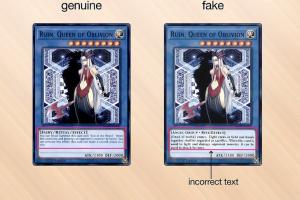Spotting the Difference: Real vs Counterfeit Yu-Gi-Oh Cards Made Easy

-
Quick Links:
- Introduction
- Understanding Yu-Gi-Oh Cards
- Why Collectors Need to Know
- Common Signs of Counterfeit Yu-Gi-Oh Cards
- Step-by-Step Guide to Checking Your Cards
- Case Studies and Expert Insights
- FAQs
- Conclusion
Introduction
Yu-Gi-Oh cards have been a staple in the trading card game community since their inception. With millions of cards in circulation, the allure of collecting these cards has led to a booming market. However, this popularity has also made it a target for counterfeiters. This comprehensive guide will help you discern between authentic Yu-Gi-Oh cards and counterfeits, ensuring that your collection remains valuable and genuine.Understanding Yu-Gi-Oh Cards
Yu-Gi-Oh cards come in various types, including monsters, spells, and traps, each with unique designs and attributes. Authentic cards are manufactured with specific materials and printing techniques which contribute to their longevity and aesthetic appeal. Understanding these nuances will help you identify the originals.Types of Yu-Gi-Oh Cards
- Monster Cards
- Spell Cards
- Trap Cards
Card Rarity
Yu-Gi-Oh cards are categorized into various rarity levels, including common, rare, ultra-rare, and secret rare. Counterfeit cards often misrepresent these rarities, making it crucial for collectors to recognize the differences.Why Collectors Need to Know
The rise of counterfeit Yu-Gi-Oh cards poses a significant risk to collectors. Understanding how to distinguish between real and fake cards not only protects your investment but also enhances the integrity of the trading card community.Common Signs of Counterfeit Yu-Gi-Oh Cards
Recognizing counterfeit cards can be challenging, especially for newcomers. Here are some common signs to look out for:1. Card Thickness and Texture
Authentic Yu-Gi-Oh cards have a specific thickness and texture. Counterfeit cards often feel too thick or too thin and may lack the smooth finish of genuine cards.2. Printing Quality
Examine the printing quality. Authentic cards have sharp, clear images with vibrant colors. Counterfeits often display fuzzy images or colors that are off.3. Holographic Features
Many rare Yu-Gi-Oh cards feature holographic images. Check these carefully; counterfeit holograms may appear dull or misshapen.4. Borders and Edges
Inspect the borders and edges of the cards. Authentic cards have clean, consistent borders, while counterfeits may have uneven edges or poorly cut borders.5. Ink Smell
A lesser-known trick is to smell the card. Authentic Yu-Gi-Oh cards have a specific ink smell, while counterfeits may have a more chemical-like odor.Step-by-Step Guide to Checking Your Cards
To ensure that you're holding a genuine Yu-Gi-Oh card, follow this detailed step-by-step guide:Step 1: Visual Inspection
Start by visually inspecting the card under good lighting. Look for discrepancies in color, print quality, and design.Step 2: Feel the Card
Hold the card and feel its texture. An authentic card will have a familiar smoothness.Step 3: Light Test
Hold the card up to a light source. Authentic cards will allow some light to pass through, revealing the subtle textures.Step 4: Compare with Known Authentic Cards
If possible, compare the card with a known authentic counterpart. This will help you spot any differences more easily.Case Studies and Expert Insights
To further boost your understanding, let’s explore some real-world cases of Yu-Gi-Oh card counterfeiting.Case Study 1: The Rise of Fake Blue-Eyes White Dragons
The Blue-Eyes White Dragon is one of the most iconic Yu-Gi-Oh cards. In recent years, several counterfeit versions have surfaced, leading to significant losses for collectors.Expert Opinion
According to Dr. Emily Hargrove, a trading card expert, “The best way to protect yourself is education. Know your cards, and you’ll be less likely to fall victim to counterfeits.”FAQs
1. How can I tell if my Yu-Gi-Oh card is real?
Check for thickness, print quality, and examine the holographic features.2. Are there specific cards that are more often counterfeited?
Yes, high-value cards like Blue-Eyes White Dragon are frequent targets for counterfeiters.3. Can I use a magnifying glass to check my cards?
Absolutely! A magnifying glass can help you inspect the print quality closely.4. What should I do if I suspect a card is fake?
Consult an expert or compare it with a verified authentic card.5. Are there any tools for detecting fake Yu-Gi-Oh cards?
Some collectors use UV light to check for authentic holograms.6. Can I return a fake card?
It depends on where you purchased it. Always check the return policy.7. Is there a community for Yu-Gi-Oh collectors that can help?
Yes, there are many online forums and groups dedicated to Yu-Gi-Oh collecting.8. How do I store my Yu-Gi-Oh cards to prevent damage?
Use protective sleeves and store them in a cool, dry place.9. What are the consequences of selling counterfeit cards?
Selling counterfeit cards can lead to legal repercussions and damage your reputation as a collector.10. Where can I find more information about card authenticity?
Websites such as TCGPlayer and Beckett offer resources and tips on card authenticity.Conclusion
Understanding how to identify real vs counterfeit Yu-Gi-Oh cards is essential for any serious collector. By following the guidelines in this article, you can ensure that your collection remains authentic and valuable. Remember, education is your best defense against counterfeit cards.Random Reads
- Mobile network not available fixes
- Mirror your screen to tv
- How to open dxf files
- How to open draw io file in 3 easy steps
- How to make a free website with google sites
- How to install granite countertops
- How to install gta 4
- How to tell if a wall is load bearing
- How to register a dll
- How to refresh ip address windows